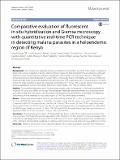| dc.contributor.author | Joseph Osoga, John Waitumbi, Bernard Guyah, James Sande, Cornel Arima, Michael Ayaya, Caroline Moseti, Collins Morang’a, Martin Wahome, Rachel Achilla, George Awinda, Nancy Nyakoe & Elizabeth Wanja | |
| dc.date.accessioned | 2022-01-29T09:20:46Z | |
| dc.date.available | 2022-01-29T09:20:46Z | |
| dc.date.issued | 2017 | |
| dc.identifier.uri | https://repository.maseno.ac.ke/handle/123456789/4751 | |
| dc.description | DOI 10.1186/s12936-017-1943-4 | en_US |
| dc.description.abstract | arly and accurate diagnosis of malaria is important in treatment as well as in the clinical evaluation of drugs and vaccines. Evaluation of Giemsa-stained smears remains the gold standard for malaria diagnosis, although diagnostic errors and potential bias estimates of protective efficacy have been reported in practice. Plasmodium genus fluorescent in situ hybridization (P-Genus FISH) is a microscopy-based method that uses fluorescent labelled oligonucleotide probes targeted to pathogen specific ribosomal RNA fragments to detect malaria parasites in whole blood. This study sought to evaluate the diagnostic performance of P-Genus FISH alongside Giemsa microscopy compared to quantitative reverse transcription polymerase chain reaction (qRT-PCR) in a clinical setting. | en_US |
| dc.publisher | Springer | en_US |
| dc.subject | : Malaria, PGenus fuorescent in situ hybridization, Microscopy, Quantitative real-time PCR, Performance | en_US |
| dc.title | Comparative evaluation of fluorescent in situ hybridization and Giemsa microscopy with quantitative real-time PCR technique in detecting malaria parasites in a holoendemic region of Kenya | en_US |
| dc.type | Article | en_US |

